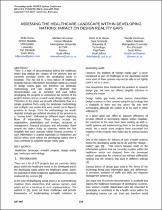 ResearchSpace
ResearchSpace
Assessing the healthcare landscape within developing nations: impact on design reality gaps
JavaScript is disabled for your browser. Some features of this site may not work without it.
- ResearchSpace
- →
- Research Publications/Outputs
- →
- Conference Publications
- →
- View Item
| dc.contributor.author |
Ouma, S

|
|
| dc.contributor.author |
Herselman, Martha E

|
|
| dc.contributor.author |
De la Harper, R

|
|
| dc.contributor.author |
VanGruen, D

|
|
| dc.date.accessioned | 2010-12-07T08:28:20Z | |
| dc.date.available | 2010-12-07T08:28:20Z | |
| dc.date.issued | 2010-09 | |
| dc.identifier.citation | Ouma, S, Herselman, M, De la Harper, R and VanGruen, D. 2010. Assessing the healthcare landscape within developing nations: impact on design reality gaps. Proceedings of the IASTED Conference HEALTH INFORMATICS (Africa HI 2010), Gaborone, Botswana, 6-8 September 2010, pp 210-216 | en |
| dc.identifier.uri | http://hdl.handle.net/10204/4608 | |
| dc.description | Proceedings of the IASTED Conference HEALTH INFORMATICS (Africa HI 2010), Gaborone, Botswana, 6-8 September 2010 | en |
| dc.description.abstract | There is a lack of documentation within the healthcare sector that depicts the context of the services that are currently provided within the developing world in hospitals. This has led to a mass failure of healthcare projects that are information technology based as a result of design reality gaps. We therefore use landscape methodology and case studies to illustrate how documentation can be extracted and used before developing the projects to understand the context of the project domain and as a result avoid design reality gaps. Therefore in this paper we provide information flow in a simple graphical form using the landscape methodology and multiple case studies that were carried out in Nyanza province in Kenya. From the methodology the results depicted include geo political structure of the province in a “canvas form”, followed by different layers depicting flows of information. These layers include the organisation, stakeholders and services, structures of management, financial structures and information flows around the object study as observed within the five hospitals that were assessed within Nyanza province. If such information is availed especially to researchers and NGOS which work within the developing nations then it may contribute to avoid the design reality gaps. | en |
| dc.language.iso | en | en |
| dc.publisher | Africa HI 2010 | en |
| dc.relation.ispartofseries | Conference Paper | en |
| dc.subject | Healthcare landscape | en |
| dc.subject | e-Health projects | en |
| dc.subject | Design reality gap | en |
| dc.subject | Landscape methodology | en |
| dc.subject | Health informatics | en |
| dc.subject | Africa HI 2010 | en |
| dc.title | Assessing the healthcare landscape within developing nations: impact on design reality gaps | en |
| dc.type | Conference Presentation | en |
| dc.identifier.apacitation | Ouma, S., Herselman, M. E., De la Harper, R., & VanGruen, D. (2010). Assessing the healthcare landscape within developing nations: impact on design reality gaps. Africa HI 2010. http://hdl.handle.net/10204/4608 | en_ZA |
| dc.identifier.chicagocitation | Ouma, S, Martha E Herselman, R De la Harper, and D VanGruen. "Assessing the healthcare landscape within developing nations: impact on design reality gaps." (2010): http://hdl.handle.net/10204/4608 | en_ZA |
| dc.identifier.vancouvercitation | Ouma S, Herselman ME, De la Harper R, VanGruen D, Assessing the healthcare landscape within developing nations: impact on design reality gaps; Africa HI 2010; 2010. http://hdl.handle.net/10204/4608 . | en_ZA |
| dc.identifier.ris | TY - Conference Presentation AU - Ouma, S AU - Herselman, Martha E AU - De la Harper, R AU - VanGruen, D AB - There is a lack of documentation within the healthcare sector that depicts the context of the services that are currently provided within the developing world in hospitals. This has led to a mass failure of healthcare projects that are information technology based as a result of design reality gaps. We therefore use landscape methodology and case studies to illustrate how documentation can be extracted and used before developing the projects to understand the context of the project domain and as a result avoid design reality gaps. Therefore in this paper we provide information flow in a simple graphical form using the landscape methodology and multiple case studies that were carried out in Nyanza province in Kenya. From the methodology the results depicted include geo political structure of the province in a “canvas form”, followed by different layers depicting flows of information. These layers include the organisation, stakeholders and services, structures of management, financial structures and information flows around the object study as observed within the five hospitals that were assessed within Nyanza province. If such information is availed especially to researchers and NGOS which work within the developing nations then it may contribute to avoid the design reality gaps. DA - 2010-09 DB - ResearchSpace DP - CSIR KW - Healthcare landscape KW - e-Health projects KW - Design reality gap KW - Landscape methodology KW - Health informatics KW - Africa HI 2010 LK - https://researchspace.csir.co.za PY - 2010 T1 - Assessing the healthcare landscape within developing nations: impact on design reality gaps TI - Assessing the healthcare landscape within developing nations: impact on design reality gaps UR - http://hdl.handle.net/10204/4608 ER - | en_ZA |





